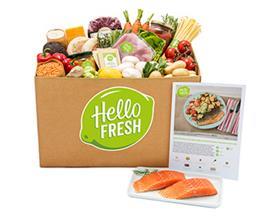
Analysts with an eye on food delivery can’t have missed the trend set to shape 2017: recipe boxes.
The concept is simple. Subscribers sign up to internet-only services like Hello Fresh, Gousto or Mindful Chef, and receive a regular box full of ethically-sourced meat, fish and veg delivered to their door. But rather than using their own culinary skills to wangle daily meals, consumers get carefully portioned-out ingredients, plus recipe cards and online support, as a guided way to cook from scratch.
According to data from purchase intelligence company Cardlytics, recipe boxes are already proving popular. It reports that spend at Hello Fresh and Gousto rose a massive 65 per cent in the first half of 2016. Meanwhile, Gousto claims it provides over 8.5 million meals worldwide and Mindful Chef has already delivered 150,000 boxes since it launched in 2015.
Vhari Russell from The Food Marketing Expert believes that the rise of recipe boxes chimes with the growing trend for time-poor professionals wanting to cook healthy, Instagram-ready meals. “At the minute people want to cook from scratch but they lack the time to collate the ingredients and to work out exactly what they want to cook,” she says.
“The technology behind the schemes is also really efficient now and these platforms are powerful and easy to use. People are more used to ordering online and trust that deliveries won’t go missing. This puts recipe box companies in an excellent position.”
Increasing interest in recipe boxes goes hand-in-hand with the growth in online food retail, as Timo Boldt, CEO at Gousto, notes. “The share of online food is set to grow from five per cent right now to 10 per cent by 2020,” he says. “In financial terms this translates to another £10 billion shifting into the online channel, according to IGD – that’s a huge opportunity for several companies, and we’re currently in the leading position to benefit from this seismic shift.
“In a nutshell, recipe boxes make life easier (there’s no need to write shopping lists, go to the store, or weigh and measure ingredients), better (suddenly you can cook a huge range of tasty, balanced meals from scratch in 20 minutes), and more natural (we source much of our produce from British farms and work closely with sustainable farmers).”
That’s good news for consumers, but potentially bad news for the supermarkets. Cardlytics reports that the growth of recipe boxes has led to a “small yet notable bite out of supermarket sales.” And while consumers who used online takeaway services like Deliveroo spent 9.2 per cent more on their regular food run, users of Hello Fresh and the like splashed out 2.8 per cent less.
Boldt isn’t surprised by this drop in regular food shops. “Recipe boxes are a sharp contrast to the way the grocery industry has worked up to now,” he says. “People simply don’t enjoy going to the supermarket. You often end up leaving a supermarket with more food than you need, or you spend more than an hour in there trying to find everything on a long shopping list.”
Yet it isn’t game over for the mults just yet. Though their growth is undeniable, recipe box companies still have big barriers to overcome. And the biggest could be profitability.
Recipe box schemes are based around a subscription system – which means they have to constantly sign up new users to beat the competition. This means investing heavily in marketing money-off deals to tempt people to try the service, which eats into profits. For instance, according to The Grocer, Hello Fresh was left with losses of €45.7m in the first half of 2016, up from €21m in 2015. That might well be enough to put off new investors.
Despite this, right now there seems to be no let up in appetite for the idea. “It’s an enviable position – they’ve got a growing audience and there’s plenty more people who haven’t tried them yet,” says Russell. “The numbers game is still on their side.”



